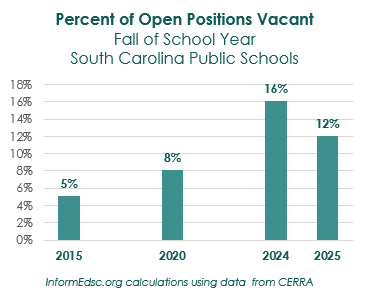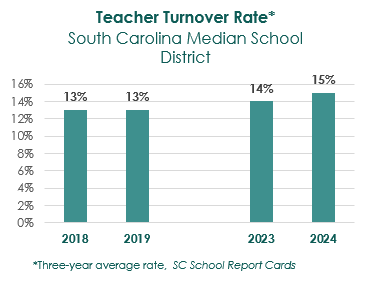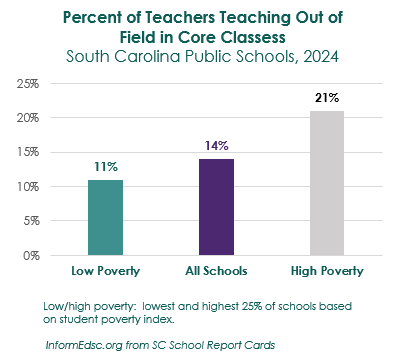December 2024
The teacher shortage in South Carolina improved this year. At the start of the 2024-25 school year, 12% of open teaching positions in the state had not been filled—a decrease from 16% the year before. Still the vacancy rate was more than twice what it was ten years earlier (see chart on right). At the start of this latest school year, school districts in South Carolina reported a total of 1,050 vacant teaching positions.1*

The teacher turnover rate in the state, however, continues to inch higher. For the 2023-24 school year, the annual turnover rate (three-year average) at the median school district was 15% (see chart below right). Of the 72 school districts in the state in 2023-24, twelve had a three-year average rate above 20% with the highest rate above 30%.2 At 20% a school district is replacing one in five teachers every year. (Discover more facts on vacant positions and turnover rates in the “Teachers” data section of this website.)
This trend has several important implications for public school students and staff:
- High rates of teacher turnover adversely impact student achievement in both math and English language arts and have a large financial cost;
- An increasing number of classes are taught by out-of-field teachers, which short changes student learning and makes it harder to retain these teachers;
- Growing inequity: in general, high rates of turnover have a larger detrimental effect on the achievement of low-performing and Black students; teacher attrition and out-of-field teaching is greater at higher poverty schools; and teachers serving special needs students have the highest number of vacant positions.

High rates of teacher turnover harm student achievement. High rates of teacher turnover have an adverse impact on student achievement.3 “Students in grade levels with higher turnover score lower in both English language arts (ELA) and math.”4 While turnover can lead to more effective teachers in a school, “there is a disruptive effect of turnover beyond changing the distribution in teacher quality.”5
Turnover has a large financial cost. School districts spend a lot to replace teachers who leave—funds not available for improving student learning and the teacher work environment.6 “Urban districts, on average, spend more than $20,000 on each new hire, including school and district expenses related to separation, recruitment, hiring, and training. These investments don’t pay their full dividend when teachers leave within 1 or 2 years after being hired.”7
Teaching out of field harms student learning and teacher retention. Another result of a large number of vacancies is positions being filled with out-of-field teachers. Research shows that this situation can harm student learning as well as the retention of those teaching out of field.8 In South Carolina in 2024, 14% of those teaching in core classes (math, English language arts and science) were teaching a subject for which they did not have the appropriate certification. As shown in the chart below, the rate in high-poverty schools (21%) was nearly twice that of low-poverty schools (11%).9 (Find more facts on out-of-field teaching in the “Teachers” data section of this website.)

Increased inequity. The teacher shortage increases education inequity in South Carolina in these three ways: 1) Research shows that low-performing and Black students experience larger detrimental effects from teacher turnover in ELA and math achievement;10 2) turnover and out-of-field teaching occurs at a higher rate at higher poverty schools; and 3) the largest number of teacher vacancies are in the special education field serving students with disabilities, who, on average, perform more than three years below their nondisabled peers.11 For a school community, these effects lead to “long-term destabilization of low-income neighborhood schools, which lose continuity in relationships between teachers, students, parents and community.”12
“We know that having a highly qualified educator in the classroom is essential to student success and that when we have a more diverse teacher population, we serve all students better.
Jenna Hallman, PhD, NBCT
Addressing the teacher shortage is integral to South Carolina’s ability to improve student outcomes, and that requires innovation and collaboration to support the profession and invest in the educator workforce of the future.”
Executive Director
Center for Educator Recruitment, Retention, & Advancement (CERRA-South Carolina)
Three main reasons for the shortage: pay, administrator support, and burnout. On average, more than 7,000 educators in SC public school districts leave their teaching/service positions each year.13 In a recent sample exit survey of South Carolina teachers, 80% of those who left the profession “cited salary as the main factor in considering a return to the classroom. The survey also revealed that 62% of the teachers pointed to the need for a strong administrative team and collegial support for them to return to the classroom. Stress and burnout are widespread among teachers. More than 60% of the state’s teachers reported that they mostly or always feel used up by the end of the workday and feel emotionally drained from their work.”14
These statistics are backed up by findings at the national level.
Most teachers feel underpaid. In a national survey only 34% of teachers said that their base salary was adequate, compared with 61% of working adults.15 Higher pay would also attract higher-achieving college students to the education field.16
The national survey also demonstrated that “raising pay alone may not improve teacher well-being or retention. Improvements in working conditions are also required.”17 Research confirms that school working conditions are highly predictive of teachers’ stated intentions to remain in or leave their schools.18 Teachers’ perceptions of their administrators’ support are the most important factor in teachers’ intention to leave,19 including administrator support for teacher leadership.20
State efforts to address the shortage. The state has made several efforts to address some of these issues. This includes 1) increasing teacher pay: for example, over the last five years, the minimum salary for a teacher with a Master’s degree and 10-years’ experience increased by $10,000; 2) beginning in the 2023-24 school year, elementary and special education full-time teachers must be given 30 minutes of uninterrupted time during the school day on a daily basis;19 and 3) also beginning in 2023-24, school districts are required to provide 6 weeks of paid maternity leave for teachers. All of this is a start.
More facts on this topic can be found on this website. Search on “shortage,” “work conditions,” “salaries,” or other terms from this post to see where more information is available.
1 Center for Educator Recruitment, Retention, & Advancement (CERRA), “South Carolina Annual Educator Supply and Demand Reports.”
2SC School Report Cards.
3Berry, B., Bastian, K.C., Darling-Hammond, L. and Kini, T., “The Importance of Teaching and Learning Conditions: Influences on Teacher Retention and School Performance in North Carolina,” Learning Policy Institute, 2021.
4Greenberg M.T., Brown J.L., and Abenavoli R.M., “Teacher Stress and Health Effects on Teachers, Students, and Schools,” The Pennsylvania State University, 2016.
5Ronfeldt, M., et al., “How Teacher Turnover Harms Student Achievement,” American Educational Research Journal, 2013.
6Berry, Learning Policy Institute.
7 Learning Policy Institute, “2024 Update: What’s the Cost of Teacher Turnover?”, 2024
8Nakar, S. and Du Plessis, A.E., “Facing the Dilemma of the Out-of-Field Teaching Phenomenon in Vocational Education and Training (VET),” Vocations and Learning, Volume 16, 2023.
9InformEdsc.org from SC School Report Cards.
10Ronfeldt.
11University of Texas Permian Basin, “Is Progress Being Made Toward Closing the Achievement Gap in Special Education?”
12Greenberg.
13CERRA.
14Berry, B., Hamm, D. and Snyder, L., “The Future of South Carolina’s Teaching Profession: Addressing Teacher Shortages & Accelerating Student-Led Learning,” ALL4SC, 2022.
15Steiner, E.D., Woo, A. and Doan, S., “All Work and No Pay — Teachers’ Perceptions of Their Pay and Hours Worked: Findings from the 2023 State of the American Teacher Survey,” RAND Corporation, 2023.
16Ordway, D., “Raising public school teacher pay: What the research says,” The Journalist’s Resource, 2020)
17Steiner.
18Berry, Learning Policy Institute.
19Steiner.
20Berry, Learning Policy Institute.
21Raven, J., “Some SC teachers will now get a daily state mandated break,” WSPA, 2023.
*In full-time equivalents. Teaching positions include classroom positions plus school librarians, counselors, psychologists, and speech language pathologists. – Center for Educator Recruitment, Retention, & Advancement (CERRA)
Notes
20241229

